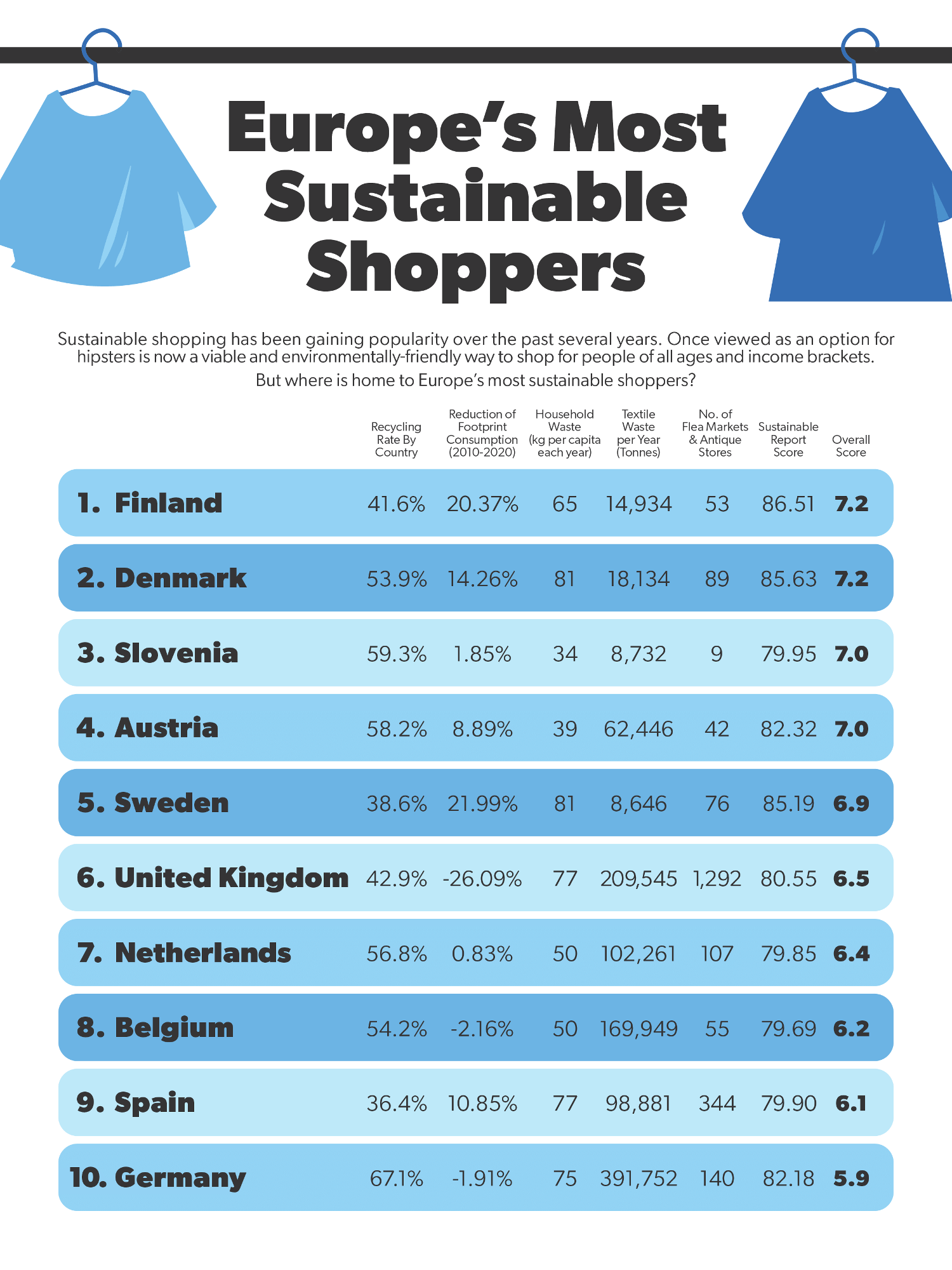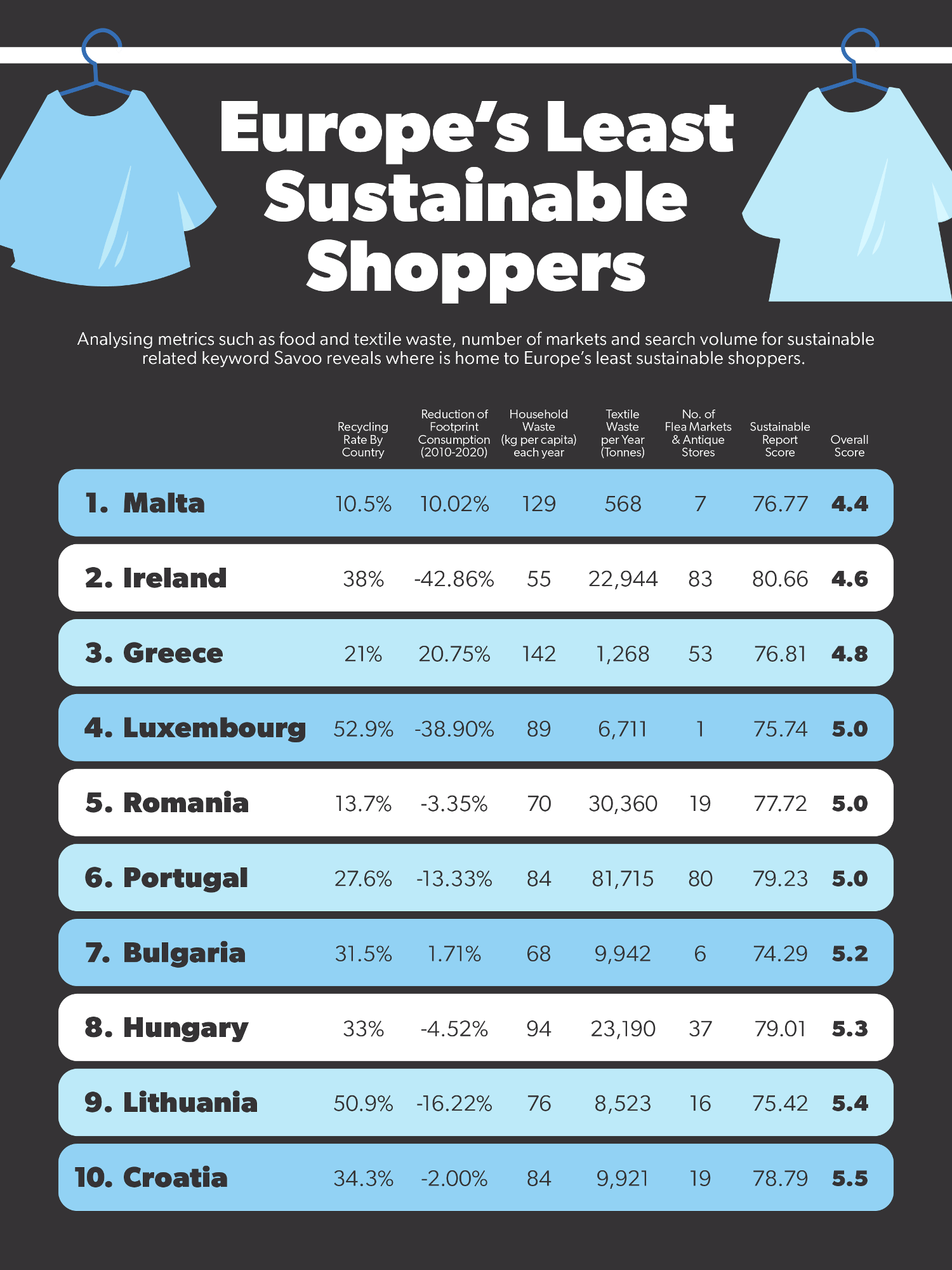
2/11/2022
From shopping second hand to avoiding plastic packaging where possible, shoppers are increasingly adopting more eco-friendly habits. As interest continues to grow and more cities adapt to a more sustainable lifestyle, where is the best place for eco-conscious consumers?
To reveal which European shoppers are leading the way with sustainability, we’ve ranked Europe’s 30 most populous countries on the following metrics:
- Sustainable Development Report ranking – Measured against 17 sustainable development goals such as climate action, and regulations to reduce emissions and promote renewable energy. The score out of 100 can be interpreted as a country’s percentage of SDG achievement.
- Recycling rates - The proportion of waste generated that is recycled.
- Textile, household and food waste - The amount of waste produced by each country in 2020 and 2021. We have looked at which countries have seen the biggest decline over the past decade in their wastage.
- Consumption footprint - The environmental and climatic impact of each country resulting from the consumption of goods and services by citizens.
- Number of flea/street markets - The number of flea/street markets and antiques shops listed on TripAdvisor across the country.
We also explored some of the UK’s most popular reselling platforms including Depop, Etsy, and eBay, to find out which brands are the most popular with sustainable shoppers.
Finland is the best country in Europe for sustainable shopping habits

Finland
Finland takes the crown as Europe’s best country for sustainable shoppers, and sits at the very top of the Sustainable Development Report’s ranking of all 193 UN Member States’, scoring 86.51 out of a possible 100.
The northern European country also reduced its consumption footprint (1) by an impressive 20.37% between 2010 and 2020, which is the fourth biggest reduction after Italy (26.03%), Sweden (21.99%) and Greece (20.75%).
Flea markets and antique stores are one area that Finland falls behind in, with just 53 in total to cater to its 5,540,720 population. These types of outlets offer shoppers a chance to snag pre-loved bargains at discounted prices, extending the life cycles of textiles and contributing to a more circular fashion industry.
Denmark
Denmark places second in our ranking and sits just below Finland in second place on the Sustainable Development Report with a score of 85.63 out of 100. In 2020, more than half (53.9%) of Denmark’s waste was recycled and its consumption footprint shrunk by 14.26% between 2010 and 2020. Textile waste is also relatively low in comparison to other countries in our ranking, with the country producing 18,134 tonnes each year.
When it comes to flea markets and antique stores, Denmark’s second-hand scene is slightly better than Finland’s, with 89 of these types of outlets compared with Finland’s 53.
Slovenia
Slovenia produces an estimated 34 kg of household waste per capita each year, which is the lowest out of all countries in our analysis. It also recycles 59.3% of its total waste. Between 2010 and 2020, Slovenia’s consumption footprint decreased by 1.85% from an already low 1.64 down to 1.61 in 2020. However, the country has just nine flea markets and antique stores, the fifth lowest out of all countries analysed.
Austria
Household waste production in Austria is almost as low as Slovenia’s with an estimated 39 kg produced per capita yearly, with 58.2% of the country’s total waste getting recycled. Austria’s consumption footprint decreased by 8.89% between 2010 and 2020, falling from 1.88 to 1.72.
Sweden
Home to numerous popular global clothing brands such as H&M, Fjällräven, and Monki, Sweden ranks fifth on the list for sustainable shopping. The Scandinavian country ranks third on the Sustainable Development Report with a score of 85.19 out of 100 and produces a relatively low level of textile waste (8,646 tonnes yearly).
Out of every country in the top 10 in our analysis, after Italy, Sweden has seen the most significant reduction in its consumption footprint, dropping by 21.99% from 2.17 to 1.74 in the last 10 years.
United Kingdom
The United Kingdom ranks in sixth place as being home to Europe’s most sustainable shoppers. With a population of almost 68 million people, the country has almost 1,300 flea markets and antique shops available, the highest number of all countries analysed. It also places in 11th place on the Sustainable Development Report with a score of 80.55 and has a recycling rate of 42.9%.
Despite this, the nation has some of the highest textile waste (209,545 tonnes yearly) after Italy, Germany, and France which has contributed to its lower ranking.
Malta is Europe’s worst country for sustainable shopping habits
On the other end of the scale, Malta, Ireland, and Greece, are Europe’s worst countries for sustainable shopping, followed by Luxembourg and Romania.

Malta
Of all countries analysed, Malta has the lowest recycling rate with just 10.5% of its total waste saved from landfill in 2020. It sits at position 33 on the Sustainable Development Report with a score of 76.77/100, and there are just seven flea markets and antique shops. Despite producing 129 kg of household waste per capita each year, the country’s total amount of textile waste is one of the lowest in our analysis, producing just 568 tonnes. This may be a result of Malta’s smaller population size (441,543).
Ireland
Ireland ranks second from the bottom for sustainable shoppers, having increased its consumption footprint by more than two fifths (-42.86%) in the 10 years leading up to 2020 - this is the largest percentage increase of any country in our ranking. Ireland is of course the birthplace of the fast fashion chain Primark (or Penneys in ROI), which has been highly scrutinised for its unsustainable practices.
Greece
Despite reducing its consumption footprint by 20.75% from 2010-2020 and producing just 1,268 tonnes of textile waste each year, Greece is still Europe’s third worst culprit for unsustainable practices. Household waste is estimated to be 142 kg per capita each year, and there are just 53 flea markets and antique stores.
Zara is the most popular second-hand brand
Clothes reselling platforms have become incredibly popular in recent years, and whether you’re looking for rare vintage wares or this season’s sell-out staples at affordable prices, these platforms have it all.
Savoo has analysed the number of listings of 30 top brands across four online second hand marketplaces to determine which are the most popular to buy second hand.

Our research reveals that Zara is the most popular second-hand brand overall, across Depop, eBay, Vestiaire Collective, and ASOS Marketplace. Interestingly, out of all the brands and marketplaces analysed in the study, Depop has the most Zara items listed at 439,696. Nike ranks just behind Zara as the second most popular brand to shop second hand, with 7,447 listings for second hand Nike pieces currently active on the ASOS marketplace.
In third place is the iconic sportswear brand adidas, and the brand was found to have a total of 467,022 listings across the four different marketplaces. Fast fashion clothing brand H&M has the next most lively resellers market, with 238,677 items listed on Depop making it the app’s fifth most popular second-hand brand. In fifth place is American lingerie brand Victoria’s Secret with a total listing of 372,291 across all four marketplaces.
Tips on how to shop more sustainably AND cost-effectively
Shopping sustainably can make a huge difference to our planet, but it doesn’t have to break the bank. Here are Savoo’s top tips to help you kick your fast fashion habit.
-
Use the 30 wears test as a benchmark. Next time you see an on-trend item that you can’t wait to add to your basket, think about whether you’d wear it a minimum of 30 times before getting rid of it. This is a great test for making sure you're thinking consciously about textile waste while helping you get the most out of your money.
-
New clothes don’t have to be brand new. Shopping is one of life’s greatest pleasures, and we’d never want to deprive ourselves of that new jeans feeling. But that doesn’t mean everything we buy has to be brand new. You can get high quality items for an affordable price by purchasing on reseller platforms like Vinted or using a clothing rental service for special occasions rather than heading to the high street. It’s also worth searching for online discount codes to see if you can cut the prices down by a few pounds.
-
Learn how to repair clothing yourself. When you find a hole or a tear in your favourite jumper, is your instinct to throw it out and buy a replacement? Why not bring it back to its former glory instead with a bit of DIY? There are plenty of free YouTube tutorials that’ll teach you the basics, and you can always enlist the help of a tailor for more complex fixes.
For more tips on how to be a sustainable shopper, please see the Savoo cost of living guide for the best tricks on bargain hunting while second-hand shopping.
Methodology
To reveal the most sustainable shoppers, we created the sustainable shopper index, scoring 30 countries against eight relevant metrics including their Sustainable Development Report ranking, recycling rates, consumption footprint, number of flea/street markets, and the amount of textile and food waste they produce. Each metric was ranked and scored to give a total score out of 10. Those scores were then combined to find the places with the most sustainable shoppers – the higher the score the more eco-conscious citizens were found to be.
The study also looked into the search volume of sustainable related terms.
To discover the most popular second-hand brand, we analysed the number of listings of 30 of the top fashion brands across four second hand online marketplaces (Depop, Asos, Ebay and Etsy). Each metric was ranked and scored to give a total score out of 10. Those scores were then combined for a final total.
(1) A country’s consumption footprint refers to the size of the area needed to produce the materials it consumes, combined with the area needed to absorb the waste.
Get discounts at these popular retailers with our voucher codes and promo codes
- Pets at Home
- MuscleFood
- early learning centre
- Disney Store
- Argos
- John Lewis
- Debenhams
- TUI
- Marks & Spencer
- SHEIN
- Buyagift
- Zavvi
- First Choice
- The Hut
- Dorothy Perkins
- New Look
- Karen Millen
- Footasylum
- Clarks
- H Samuel
- Ernest Jones
- Tesco
- Sainsbury's
- Interflora
- Hotel Chocolat
- Boots
- Holland and Barrett
- LOOKFANTASTIC
- The Body Shop
- B&Q
- Wickes
- Dunelm
- ao.com
- Currys
- Nike.com
- SPORTS DIRECT
- Halfords
- Myprotein
- Domino's
- boohoo
- Missguided
- HP
- Sky
- BT Broadband
- Travelodge
- lastminute
- Bulk
- Samsung
- Booking.com
- Boomf
- In The Style
- Pizza Hut
- Ted Baker
- Hive Home
- Omio
- Mindful Chef
- Amazon
- Amazon Prime Free Trial
- VonHaus
- Gtech
- BAM
- Home Essentials
- Alienware
- Gousto
- Moonpig
- Pandora
- Papa John's
- Toolstation
- eBay
- NordicTrack
- Bloom and Wild
- Quiz
- Asos
- Superdrug
- JD Sports
- Temu